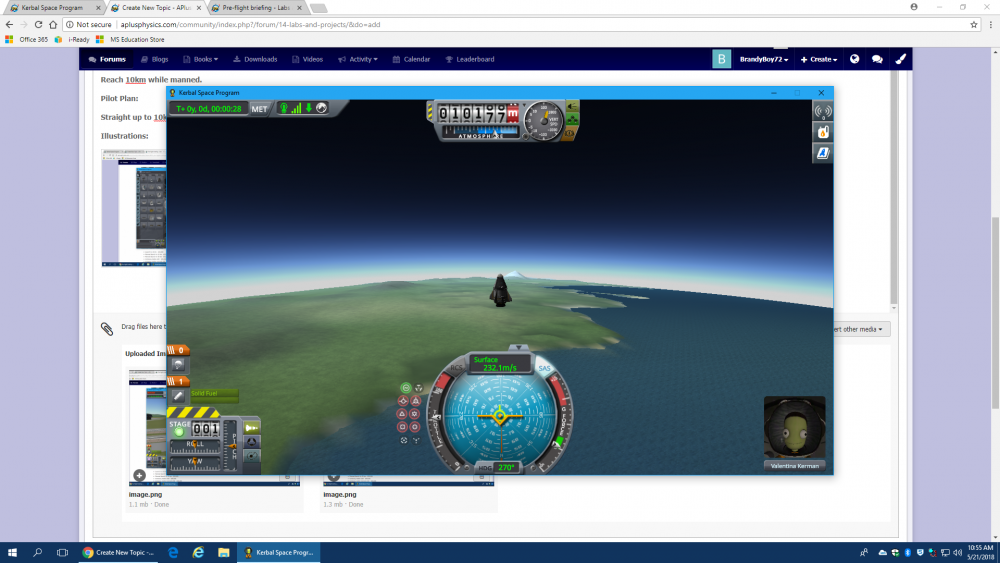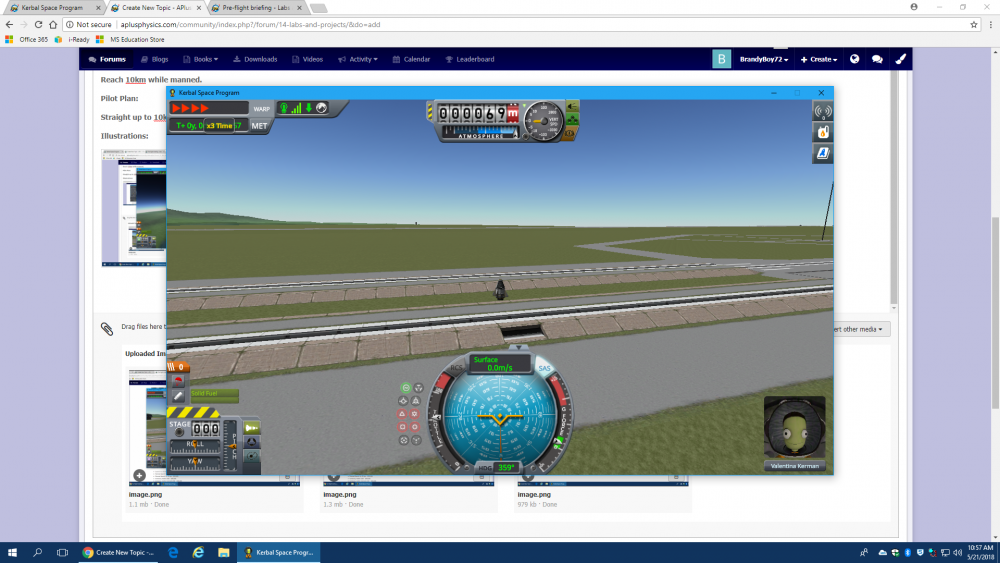
BrandyBoy72
Members-
Posts
49 -
Joined
-
Last visited
-
Days Won
1
Content Type
Profiles
Forums
Downloads
Blogs
Events
Store
Everything posted by BrandyBoy72
-
BS Enterprises Starting funds: $84,478 Vehicle name: Sweeping Sensation Parts and Cost: Mk 1 Command Pod, Mk 16 parachute, Stack Decoupler x 2, FL-R25 RCS Fuel Tank x 1, FL-T100 Fuel Tank, FL-T400 x 3, LV-909 "Terrier" Liquid Fuel Engine, LV-T45 "Swivel" Fuel Engine, Radial Decoupler x 2, RT-10 "Hammer" Solid Fuel Booster x 2, Nose caps x 2, AV-R8 Winglet x 4 Total cost: $10,522 Ending Funds: $73,956 Design Goals: Enough rocket power and fuel with a light weight body to get into stable orbit. Launch Goals: Reach manned orbit at least 70km above Kerbin. Pilot Plan: Use initial boosters to get into atmosphere and then use remaining fuel after decoupling to lose weight and get into orbit. Illustrations: Launch Time: 10:32 am Team Members: Roman St. Croix, Brandon Bansbach Play by Play: Launched with solid fuel to get into atmosphere and then decouple to lose weight. We flew at an angle sufficient for getting into orbit, the rocket was flown to 70km and then thrusters were turned off until the apoasis was reached, to attain max height. Thrusters were turned back on and orbit was achieved soon after. Time of Flight: 25 mins Summary: Stable manned orbit by Jebodiah Kerbin Learnings: Need a lot of fuel to get into orbit, would need more if anything was wanted beyond that. What's Next? Land on the Mun. Milestone Awards: Manned launch to 50 km - $15,000 Achieving stable orbit - $20,000 Achieving stable manned orbit - $25,000 Total Awarded: $60,000 Total Funds: $133,956
-
BS Enterprises Starting funds: $60,000 Vehicle name: Tide Pod Mk1 Parts and Cost: Mk1 Command Pod, Mk16 Parachute, RT-5 "Flea" Solid Fuel Booster. Basic Fin x 4 Total cost: $1,322 Ending Funds: $58,678 Design Goals: Stable starting rocket with efficient costs and a safe return to Kerbin. Launch Goals: Reach 10km while manned. Pilot Plan: Straight up to 10km, and straight down with a parachute deployed for a safe landing. Illustrations: Launch Time: 10:56 am Team Members: Roman St. Croix, Brandon Bansbach Play by Play: First, we set the throttle to 2/3. We then launched and moved straight upwards in the atmosphere to about 12km, then traveled straight down, deploying the parachute at 5km, and it activated at 2km to bring Valentina Kerbin to a safe landing. Time of Flight: 10 minutes Summary: Our flight was a success for Kerbin kind. Learnings: We learned how to set stages and how to adjust parachute settings, just the basics. What's Next? Our next goal is to reach a height of 50km and return safely. We are slowly preparing ourselves for a trip to the Mun. Milestone Awards: Launch to 10 km - $5,000 Manned launch to 10 km - $20,000 Total Awarded: $25,000 Total Funds: $84,478
-
Just a Little Hot Air
BrandyBoy72 commented on etracey99's blog entry in Home is Where Your Displacement is Zero
I remember watching a Curious George episode as a kid that explained hot air balloons and it blew my mind -
This is an example of how magnets can be used for levitation, or hovering if you will. All this is, is simply the force of the magnet overcoming the force of gravity of the magnet and the liquid. In this way, a "hover board" would be nothing other than a force keeping something off the ground, which is just what a normal force is when you have an object sitting on the floor. However, using magnets for levitation is cool because you cannot see the force acting on the object, and the force can also be transferred through things, putting your hand between something being levitated by a magnet would not stop the magnetic repulsion, which is pretty cool to think about and even cooler to see.
-
Pole vaulting is a very good example of the transfer of momentum. You are transferring energy from running down the runway into bend in the pole, and then that pole rotates after you jump, making the pole push you vertically. As a pole vaulter myself, I can say it is not all that complicated, it does not require you to be a physics student to get over the bar. However, it is super fun! It must be flying in the air and feeling the push of the pole behind you as you kick your legs up, hoping to get over that height you set for yourself. Common things people will say about pole vaulting: "isn't it scary?" - It's more exhilarating than scary "What if the pole breaks?" - All poles have weight requirements, so a pole rated 150 would only be safe for someone who weighs under 150 lbs. Also these poles are extremely elastic, being made of carbon fiber or fiber glass, and it is very rare that one would break. "I'm afraid of heights" - It's not that high.. well that's subjective
-
Personally I prefer building wall with working outlets and light switches over building a circuit in a lab, we do this in my Electric and Alternative Energy class. To me it just makes more sense, and I guess my time in physics is what gives me a good sense of how things like the electrical guts of a wall actually work. It seems like knowing how electrons flow through a system and through a switch is the basics for any circuit, functional or theoretical. However, I like that putting together a wall in this trades class that I take is actually quite challenging to understand still. Every basic wire running through the wall has 3 component wires: a hot, a neutral, and a ground. The hot is where the electrons flow when an appliance is in use, most of the time in AC (alternating current). The neutral is where the electrons flow to leave the circuit, and the ground is essentially like another neutral, but it is like a safety device. If a wire coating were to break, exposing the wire, instead of sending out random shocks starting a fire or electrocuting someone, the electrons will flow to the ground. And the wires are not as simple as connecting things with alligator clips, these are a bit more permanent. Sometimes you need to connect up to four wires at the same time all going to different places, this calls for a pig tail, which is essentially twisting the wires together so they all run to each other and then are capped off. This skill is both technical and requires a knowledge about how electrons will flow, and I really enjoy that.
-
This is a video of a levitating frog. Apparently a 10 Tesla magnetic coil is being used to lift him. This is possible because pretty much all organisms have small amounts of ferromagnetic materials inside of them. And no this does not hurt the frog because the force is spread out over the entire body, but he is probably freaking out a little bit inside.
-
Some magnets are more, uh, magnetic than others? Yes some magnets have a stronger magnetic force than others. Iron, nickel and cobalt atoms have more electrons orbiting in one direction than the other. This means they produce smaller currents like electromagnets. However, ferromagnetic metals like iron, nickel and cobalt like to line up into larger areas. These areas will line up, north to south like any other magnet if you put them in a strong magnetic field. You can even line up these areas yourself, maybe you've done this before, you take an actual magnet and rub it one way across a ferrous material like a paperclip, and in doing so you will line up the inside structure of the clip, making it a little magnetic for a while until it gets jumbled up again. With very strong magnets, like rare earth magnets, the structure of the alloy tends to make it very hard to change the direction of the magnetic field. This means that more of them stay lined up, and you get a stronger magnet. So leave the heavy lifting to the rare earth magnet neodymium magnets and maybe just keep the fridge magnets around to hold up your physics grade sheet...
-
Today at my locker, I took a stand against lockers everywhere. Every morning coming into school I visit my locker first thing to put away my jacket. I have been needing to wear a jacket for longer this year because of the ceaseless cold we've been having here in New York. To get to the point, I would come in from the cold wearing my jacket and go to my locker to put it away for the day. Like rubbing your socks on a carpet to induce a charge on yourself, the act of taking off my fleece jacket rubs it on my shirt, inducing the charge. This charge is then discharged when I touch my locker to hang up the jacket. If anyone else has also experienced this, they will know what kind of fear it can bring a person. The shock is unpleasant, yet not overly painful, but surprising nonetheless. This happens because the jacket rubs electrons off on my body, and then touching the locker which is grounded causes those electrons to leave, and in quite a hurry. So today I rebelled against this by throwing my jacket in my locker and then closing it with my show, which is insulated or something. I haven't felt a shock yet today, I wonder if I still have excess electrons...
-
I've been watching this gif for like 5 straight minutes
-
HOW DO AIRCRAFT CARRIERS STAY AFLOAT??(INSANE)
BrandyBoy72 commented on TheNightKing's blog entry in CLICKBAIT TITLE
came for the boats, stayed for the science -
Generators, Enough Said
BrandyBoy72 commented on HegelBot153's blog entry in AP Physics C Student Blog
Concise and profound, homerun. -
1 Gauss = Mx/cm2 = 10-4T = a guy = /gous/ noun, a unit of magnetic induction 1 Tesla = measurements for magnetic fields = 104G = the SI unit of magnetic flux density = another guy 1 Newton = who knows? Wow look, these units are all named after some cool science guys, this is concurrent with many other units; Ampere, Kelvin, Pascal, Coulomb, Watt, Volt(a), Ohm, Farad(ay), Weber, Joule, and of course the Becquerel named after none other than Antoine Henri Becquerel. Seems like you gotta be a pretty smart science guy to have a unit named after you, wonder when we'll get the Nye... But anyway who is this "Maxwell" and why does he get to be known for the four equations; Gauss' Law, Gauss' Law for Magnetism, Faraday's Law, and Ampere's Law? Well apparently he was pretty cool, he pretty much found that electricity, magnetism and light are all different manifestations of the same phenomenon in his theory of Electromagnetic Radiation. And these equations have been called the "Second Great Unification in Physics". So yeah, you gotta be a rad science guy to have a unit or equation named after you. Comment down below what your unit would be called and what it would pertain to!
-
Madman Speculations part 1 (WARNING: Actually Insane)
BrandyBoy72 commented on HegelBot153's blog entry in AP Physics C Student Blog
This sounds very similar to a philosophical idea known as Occam's razor, you can look into it a bit, I don't trust myself to know enough about it to explain it here in the depths of the comment section. -
A common use of a brush motor is in a fan, for example the type that is used to keep my laptop from overheating. But what exactly is that preventing, and what does overheating do to a system such as a laptop? The fan helps to keep internal units cooled down, heat is created when there is resistance in the different hardware inside the computer. With all the units preforming very close to each other, a lot of heat can be generated. This is why keeping any appliance that generates a lot of resistance should be turned off when not in use, they are just draining unnecessary power and can create enough heat to cause a fire if given the proper (or rather improper) conditions. The fans used by such appliances serves to cool off the internal devices to a certain extent, and don't actually create that much heat themselves, which is useful. There are alternative ways of keeping devices cooled down, fans are one type, but there are also liquid cooling systems which are less common and even a phase change unit, which uses a cooling technique similar to a refrigerator.
-
What exactly happens when electricity flows through a person, how does it effect their body and how can these effects be measured? People are conductive, electricity will flow through a person if able, and can do harm to a persons body, including burns and upsetting the heart. Small enough voltages might not conduct through your skin, the most susceptible place on your body is probably your tongue. In terms of Amps, 1 mA of current through your body would only cause tingling, but upwards of 75 mA could cause ventricular fibrillation, an unsteady heart rhythm that can lead to death. Amps of 1500 mA can start to burn internal organs. However amperage alone cannot determine whether a shock is deadly, factors like where the current flows through on your body are important too, this is why a small shock from an electrical shock can kill you if it travels through your heart, but a bolt of lightning can leave a person with only burns if it travels through the skin and into the ground.
-
My Semester Review Pledge to physics: I really think math is fun, it's like a puzzle, seriously no sarcasm here, I really enjoy taking math tests. They are surreal in a way, and I don't even know what surreal means, they just are and that sounds cool. But time goes by so fast and I just feel like super cool when I know what's going on, like we're speaking some secret code or something that only our class knows how to speak. Now, I need to take that same fascination and put it into the physics setting. Something about physics is different than math, perhaps it's that it's not the same kind of problems, physics problems often take quite a bit of thinking (no offense to BC calc) but, physics is much harder IMO and I think many of you can agree with me. So I (and maybe there's more of yo out there too) need to try harder in physics. period. end of story. Nope wrong JK got you good. I need to take that same feeling I get with math and have fun with physics, put some more time into the understanding part so that the problem solving part comes more naturally and is in turn more fun.
-
I recently had my wisdom teeth removed, and it wasn't even the worst experience of my life, all thanks to the Novocain. My face was completely numb, couldn't feel a thing. It's not like I couldn't feel any forces though: I could tell that my cheek was being pulled to one side because my hole head felt the force of the pull, but I could not feel anything touching my cheek, an odd experience. And after the surgery I was touching my face a lot because touching your own face when it is numb is a very weird sensation, hard to describe. And this got me to realize that when something touches you, sometimes it is only sensory, without any feeling you wouldn't even feel the force. So I then thought: if you had no feeling in you at all, would you not know if you were being pushed? What let's you know that you are falling, I think there's something to do with your inner ear or something, but otherwise what? your sight of course. This is an interesting direction to take this in... So if you ever wondered what those blocks in physics problems feel on the daily, just imagine that you have no feeling anywhere in your body, no sight, no sense of anything and you're being pulled by some weird floating rope or sliding down a frictionless incline, how does that even happen anyways?
-
Green is my favorite color, here's why: the frequency of green light is 526-606 THz(Terahertz) and it's wavelength is 495-570 nm In my opinion, green should replace yellow as a primary color, it is just so much better The colors displayed by your computer screen or TV are made of super tiny pixels made of 3 different colors, red GREEN and blue, hence RGB VS Seeing these colors very zoomed out(as your eye does) can make them seem like any other color on the spectrum from black to white But why green and not yellow, it would make sense for it to be yellow because it is one of the primary colors like red and blue? This is because red green and blue are additive colors, meaning that as you add more of the color, it gets brighter, and this makes sense to use for computers because they emit light. The reason that anything is any color, is because of how light is absorbed, if (almost) all light is absorbed by surface, it will appear black. This is why black surfaces get so hot in the summer, because they are absorbing more light energy. If a surface absorbs (almost) no light, then it will look white. So any light that is seen by your eye is reflected light off of a surface, otherwise that light will be absorbed by the surface and turned into heat. The differences in the wavelengths of the colors in light are what cause them to be absorbed by a surface or not. This has been a rudimentary explanation of light, there are of course many more things that could be discussed, perhaps that can be in a future post.
-
I was at Wendy's today, getting a drink, from one of those fancy drink dispensers. It is amazing how there are so many flavors and types of drinks to choose from, a massive increase in choice from those old ones where you could choose from a variety of like ten drinks, now it's more like 100. The machines are very compact too, all the drinks are dispensed from the same exact place on the machine. The machine is coded itself to of course give you the drink of your desire, go on the menu and select your type of drink and flavor until you've gotten to a specific drink of your liking, then hit the button. Cherry Coke, Minute Made lemonaid, or all the Poweraid flavors mixed together into your own concoction of "rainbow Poweraid" - it's all that easy, but how the drink gets into your cup is also a bit like coding, you pressing certain inputs will get different outputs, this is similar to doing a lab. To inspect different things in physics we will do certain inputs - perhaps dropping a weight, or oscillating a spring - and different outputs occur which need to be analyzed, like drinking your rainbow Poweraid, thinking it was not worth making that old guy behind you mad at how long you were taking, and it doesn't even taste that good, you probably should've just gone with one flavor, two at most. But that's how experiments go.
-
The game of Hacky Sack is a good one. Full of skill and such. The "footbag" itself goes through a lot of getting smacked around, flying through the air in parabolic arcs like any other projectile. The players in the game have to pretty much predict where the hacky sack is going to be when they hit it. Of course no one is going to set up an equation to see where the sack is and where it is going to be, that is absurd. Rather in this fast paced game players get used to the force they hit the sack with and then from there are able to use their sense of sight to see where the ball is going. This is possible because of the predictive natures of parabolic arcs, the hacky sack is going to come down with the same velocity it was kicked up with (give or take a little given air resistance). And because humans are very good at learning patterns, it is not too hard to get good at playing hacky sack. Knowing how hitting the sack differently will effect it's flight through the air is a part of learning the game, and a little part of learning physics.
-
Eardrum vs Sound
BrandyBoy72 commented on etracey99's blog entry in Home is Where Your Displacement is Zero
So decibels are the measure of the intensity of sound, does that relate to the amplitude of the sound waves, or maybe the frequency? -
I was going for a nice walk today, it was a bit cold, but it didn't bother me too much. And I didn't too much mind the somewhat cloudy sky, the sprinkled snow on the ground was a nice touch as well. At one point I came to a spot on the sidewalk where the ground beneath my feet was no longer cement, it was ice. BUT THIS, this was no fine smooth sheet of ice, this was a cracked earth beneath my feet. The first crackle that reached me made me believe that I had just found my way onto some broken glass bottle, but a quick somewhat concerned glance below proved the sound to be otherwise. The ice, cracked from both myself and no doubt a handful of other average Joes who also daringly walk the streets of Rochester on such a day, got me to think. After my midday midwinter escapade, and after a few minutes of warming up, I warmed up to the subject of Thermal Shock (this is where the somewhat sciency stuff begins). This has to do with the cracking of ice, whether from heat or from some guy walking on it. So, ice breaks, but so does other stuff, ice just might do it a bit more extravagantly, kinda like glass would, because sub atomically it has a crystalline structure to it. I'd go more into that, but that's more chemistry. In physics we like stress (preferably on objects we are testing). So, the ice is under stress, like when I walked on it, so it cracked; this happened a lot of times and very quickly. Of course, stress eventually causes failure, but what about this "Thermal Shock" Well, your time is precious so I'll do my best to sum it up for you the best I can. "Thermal shock occurs when a thermal gradient causes different parts of an object to expand by different amounts. This differential expansion can be understood in terms of stress or of strain, equivalently. At some point, this stress can exceed the strength of the material, causing a crack to form. If nothing stops this crack from propagating through the material, it will cause the object's structure to fail."
-
My good ol' guitar has been getting out of tune recently, I think it's time for a restring. The strings were not strung in the best possible way to begin with so they have slowly over time been slipping out of the tuners. Even if the guitar is re-tuned, the strings will continue to slip more and more, so they need to be taken off and replaced. I have however been putting this off for a while, while the guitar is still playable it sounds not the best. The first time I restrung my guitar, I was tuning it and a string broke, luckily it didn't hit me while flying off, because those things hurt. There's a lot of tension in those strings, they have to have lots of tensile strength to not break under the force that they are being stretched out with. Between the broken guitar and my exuberance with the skill, things have been slow going recently...
-
You may have heard before that potential energy can be described as the amount of damage something can do. Mr. Powlin gave us the example last year of something with a greater mass or speed will do more 'damage'. It should be also noted that the area which is affected by the force will determine the 'damage' and the duration of the impact. Also how the force is distributed into the object receiving the force. For example, a skier who weighs 150 lbs going 20 mph can lessen the damage of a fall by landing over a large surface area by spreading out, landing on his side rather than on an outstretched arm. Injury (damage) can also be prevented by channeling the impact through a medium which will disperse the force (a helmet). By going to the top of that hill you are increasing your potential energy, aka, increasing your potential for damage/injury, but that can be watered down by reducing speed, wearing a helmet, and of course: falling correctly.
Terms of Use
The pages of APlusPhysics.com, Physics in Action podcasts, and other online media at this site are made available as a service to physics students, instructors, and others. Their use is encouraged and is free of charge. Teachers who wish to use materials either in a classroom demonstration format or as part of an interactive activity/lesson are granted permission (and encouraged) to do so. Linking to information on this site is allowed and encouraged, but content from APlusPhysics may not be made available elsewhere on the Internet without the author's written permission.
Copyright Notice
APlusPhysics.com, Silly Beagle Productions and Physics In Action materials are copyright protected and the author restricts their use to online usage through a live internet connection. Any downloading of files to other storage devices (hard drives, web servers, school servers, CDs, etc.) with the exception of Physics In Action podcast episodes is prohibited. The use of images, text and animations in other projects (including non-profit endeavors) is also prohibited. Requests for permission to use such material on other projects may be submitted in writing to info@aplusphysics.com. Licensing of the content of APlusPhysics.com for other uses may be considered in the future.









